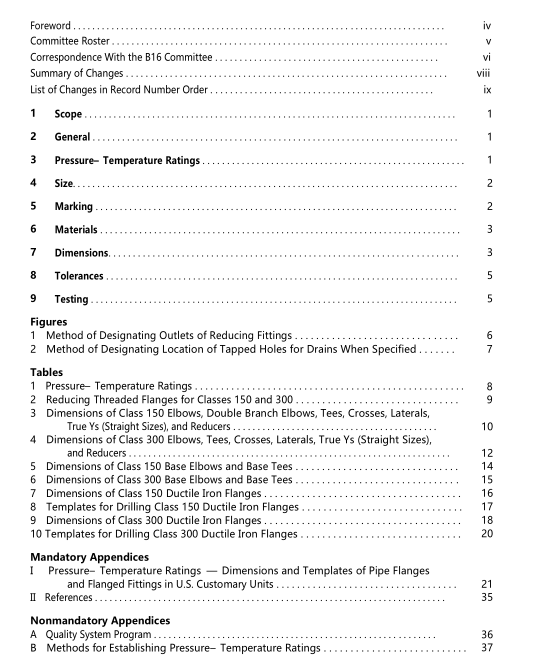ASME B16.42:2016 pdf free download Ductile Iron Pipe Flanges and Flanged Fittings Classes 150 and 300
3.2 Ratings of Flanged Joints
Ratings in this Standard apply to flanged joints thatconform to the limitations on bolting in para.6.2 and on gaskets in para.7.8, and which are made up in accor-dance with good practice for alignment and assembly.See also para.3.4.
use of the ratings for flanged joints not conformingto these limitations is the sole responsibility of the user.Aflanged joint is composed of separate and indepen-dent, although interrelated, components: the flanges, thegasket, and the bolting, which are assembled by anotherinfluence, the assembler. Proper controls must be exer-cised in the selection and application for all these ele-ments to attain a joint that has acceptable leak tightness.Special techniques, such as controlled bolt tightening,are described in ASME PCC-1.
If the two flanges in a flanged joint do not have thesame pressure- temperature ratings, the rating of thejoint at any temperature is the lower of the two flangeratings at that temperature.
3.3 Rating Temperature
Temperatures shown for corresponding pressure rat-ing shall be the material temperature of the pressure-retaining structure. It may be assumed that the materialtemperature is the same as the fluid temperature. Use
of a pressure rating at a material temperature other thanthat of the contained fluid is the responsibility of the user and subject to the requirements of any applicablecode or regulation.
3.4 Temperature Considerations
Application of the ratings in this Standard to flanged
joints at both high and low temperatures shall take intoconsideration the risk of leakage due to forces and moments developed in the connected piping or equip-ment.The provisions in paras.3.4.1 and 3.4.2 are intended to minimize these risks.
3.4.1 Flange Attachment. Threaded flanges are notrecommended for service above 260°C (500°F) if severethermal gradients or thermal cycling is involved.
3.4.2 High-Temperature Service. When used above205C (400°F), Class 150 flanged joints may develop leakage unless care is taken to avoid imposing severe exter-nal loads and/or severe thermal gradients.
3.5 Variances From Ratings
Except as provided herein, ratings are the maximumallowable working pressure for the correspondingtemperature.
exceed the rated pressure at the pressure-relieving tem- perature by no more than 1 0%. Such conditions are nec- essarily of short duration. Overpressure greater than the aforementioned under pressure-relieving conditions is the responsibility of the user, subject to the requirements of the applicable code or regulation.
3.5.2 Other Variances. Operating variations (tran- sients) that subject a flange or flanged fitting to pressure in excess of the rated pressure at the corresponding temperature are the responsibility of the user, subject to the requirements of the applicable code or regulation.
3.5.3 System Hydrostatic Test. Flanged joints and flanged fittings may be subjected to system hydrostatic tests at a pressure not to exceed the hydrostatic shell test pressure specified in para. 9.3. Testing at any higher pressure is the responsibility of the user.
4 SIZE
4.1 Nominal Size As applied in this Standard, the use of the phrase “nominal pipe size” or the designation NPS followed by a dimensionless number is for identifying the end connection of piping, flanges, or flanged fittings. The number is not necessarily the same as the inside diameter of the flange or flanged fitting. The diameter of a bolt is its nominal size. Use of nominal indicates that the stated size or dimension is only for designation, not measurement.
4.2 Reducing Fitting Sizes Reducing fittings shall be designated by the size of the openings in their proper sequence as indicated in the sketches. See Fig. 1 .
4.3 Reducing Flange Sizes Reducing flanges shall be designated by the two nomi- nal pipe sizes. See examples in Note (4) of Table 2.
ASME B16.42:2016 pdf free download
